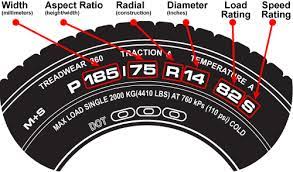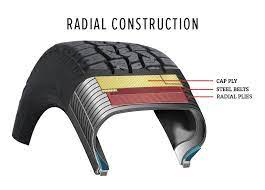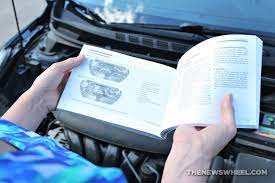How to Read Tire Size Codes
You might be forgiven for thinking tires are all more or less the same size but you would be wrong as there is a fair amount of difference. These differences are recorded as part of a code imprinted on the tire.
Why Do You Need the Right Sized Tires?
When cars are designed they are done so with purpose and with specifications. This includes the wheel wells which are made a specific size and shape. This means that you need tires of a certain size to fit correctly without them touching the sides.
You never want to have a tire that rubs against the wheel well as this will quickly damage the tire and could lead to an accident. There is some room for options when it comes to the tires but choosing ones too large or too small will not be good for your vehicle's smooth operation.

Breaking the Code
On the tires sidewall you will note there are three numbers as part of a code of sorts. There are also some letters mixed in as well which have meanings of their own. In this section we will break down this code to help you understand the tires.
Tire Type
You will note that at the start of the tire code there is a letter which for cars is usually a P. This P stands for passenger and basically means that the tires are intended for passenger vehicles. You may also see the letter LT together and this stands for Light Trucks. These tires are designed for heavier vehicles and can be inflated more.
Other tire letters of note include:
- T: A temporary tire intended as a spare which can get you to a new location where you can get a new full tire.
- ST: Stands for trailer which are the wheels you would have on a trailer but not your car.
- C: This is to signify tires used on a commercial vehicle. They are built to be stronger and more durable as they may be carrying heavier loads.
If there is no first letter then you may be looking at a European made tire and they have a different system.
The Width
The first set of numbers after the letter indicates the width of the tire. If for example it were to read 225 then this would mean that the tire's width is 225 millimeters. It is generally a three digit number and it specifies the distance between each sidewall of the tire.
Aspect Ratio
After the three digit width you should see a forward slash: "/ " followed by two more digits. These digits are the aspect ratio. Essentially it is the height of the cross-section compared to the width. If for example this number was 65 then it would mean the height of the tire was equal to 65% of the width.
This ratio makes a difference to the turning response time with high numbers meaning slower response and lower numbers indicating a quicker turn.
Construction
Following the aspect ratio you will see another letter which this time refers to how the tire is constructed. The most common one you are likely to see is R which stands for radial tire. This is made from piles of fabric, steel and polyester beneath a rubber coating. These materials lay perpendicular to the direction of tire travel making for a smooth ride and long tread life.

Motorcycle and trailer tires often have D printed on them instead of an R to indicate they are made with diagonal piles. They tend to be narrower tires and may also be called Bias-Constructed Tires, Bias Ply or X-Ply, Cross-Ply and Conventional Tires.
If you see an F before the construction letter then this means the tire is a run flat model.
Wheel Diameter
Following the construction letter is another two digit number which refers to the size of the wheel that should be used with the tire. It refers to the distance across the center of the wheel and is usually measured in inches so if this number is 17 for example it means this measurement is 17 inches.
Load Index
Following the diameter you will see another 2 digit number but this one does not refer to a unit of length rather it's about weight. It indicates the weight carrying ability of one tire and rather than the numbers being a weight they are actually from an index.
As an example a load index of 117 means the tire can take a load of 2,833 lbs. This is per tire so with all four you would multiply that weight by 4 to get the exact load capacity.
Speed Rating
The final letter in this code is part of another index and refers to the maximum speed that you should drive using these tires. Tires rated for higher speeds are designed to offer better control at these speeds than lower rated tires.
The most common ratings for family sedans, SUVs and van tires are S and T which equate to top speeds of 112 or 118 mph respectively. The average passenger vehicle usually has tires that have a rating of H or 130 mph.
There are several rating levels each having a letter associated and as you get higher in the alphabet you get higher in the speed department.
How to Interpret a Tire Sizing Code
Given the above information we will now translate a tire code to try and illustrate the point further. So for example say the tire code reads P225/65R17 100T the specifications will be as follows.
- P = Passenger vehicle tire
- 225 = Tire width of 225 millimeters
- 65 = Aspect ratio of 65%
- R = Radial Construction
- 17 = a diameter of 17 inches
- 100 = A load index weight of 1,604 lbs. per tire
- T = Maximum top speed of 118 mph
How to Pick the Right Tires for Your Car
If you are replacing a worn tire then the best way to make sure you get the right type of tire as a replacement is to inspect the old tires. They should be the correct ones already and will have the correct code information.
If the damaged tire is too worn to read check one of the other tires they should all be the same. If you are in any doubt however you should also find the tire requirements on a plaque in the door jamb of the drivers side.
Another place to search might be your owner's manual or you can research the right tires for your model on the internet.

Conclusion
As part of the code placed on the sidewall of your tires there are dimensions for width, height and diameter of the tire. These numbers will help you determine if the tire is the correct fit for your specific model of car.
You might be forgiven for thinking tires are all more or less the same size but you would be wrong as there is a fair amount of difference. These differences are recorded as part of a code imprinted on the tire.
Link To or Reference This Page
We spend a lot of time collecting, cleaning, merging, and formatting the data that is shown on the site to be as useful to you as possible.
If you found the data or information on this page useful in your research, please use the tool below to properly cite or reference Tow Ratings as the source. We appreciate your support!
-
<a href="http://towratings.net/blog/how-to-read-tire-size-codes/">How to Read Tire Size Codes</a>
-
"How to Read Tire Size Codes". Tow Ratings. Accessed on April 20, 2024. http://towratings.net/blog/how-to-read-tire-size-codes/.
-
"How to Read Tire Size Codes". Tow Ratings, http://towratings.net/blog/how-to-read-tire-size-codes/. Accessed 20 April, 2024
-
How to Read Tire Size Codes. Tow Ratings. Retrieved from http://towratings.net/blog/how-to-read-tire-size-codes/.